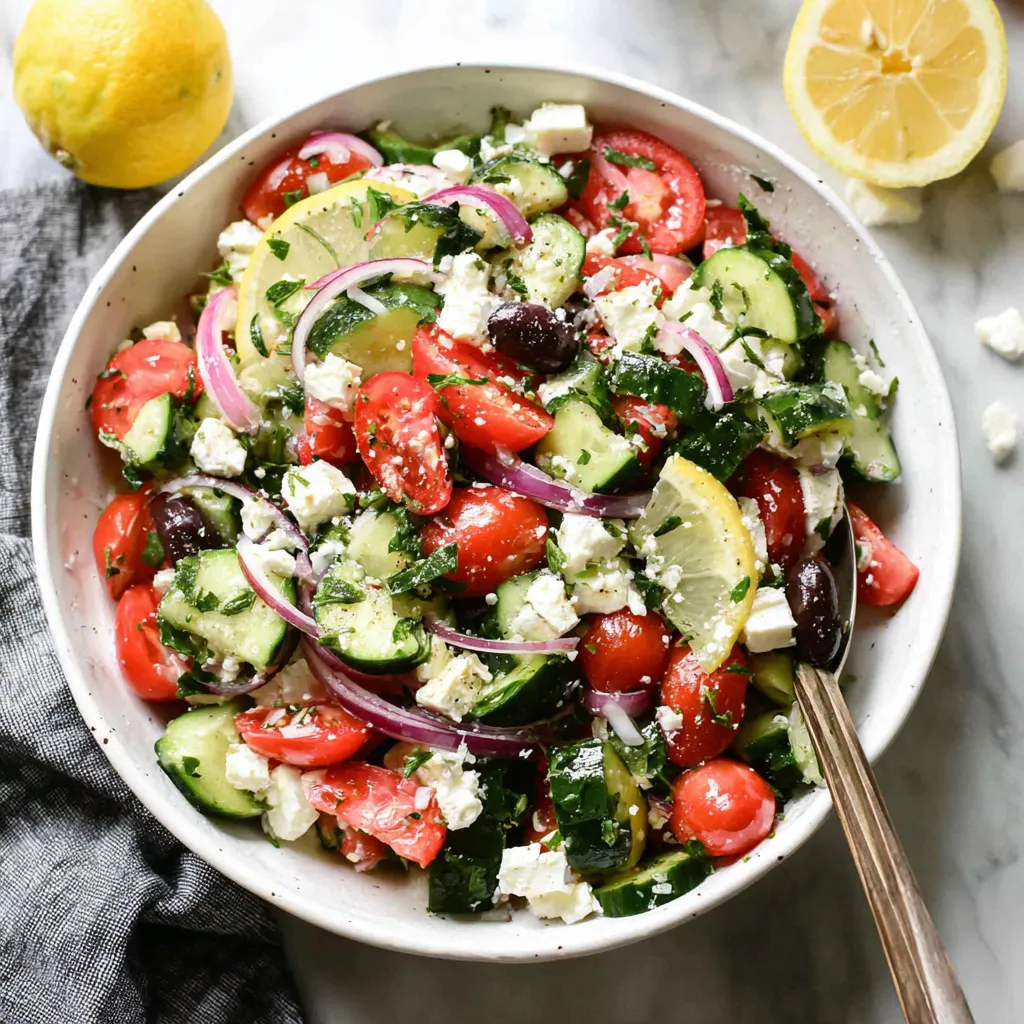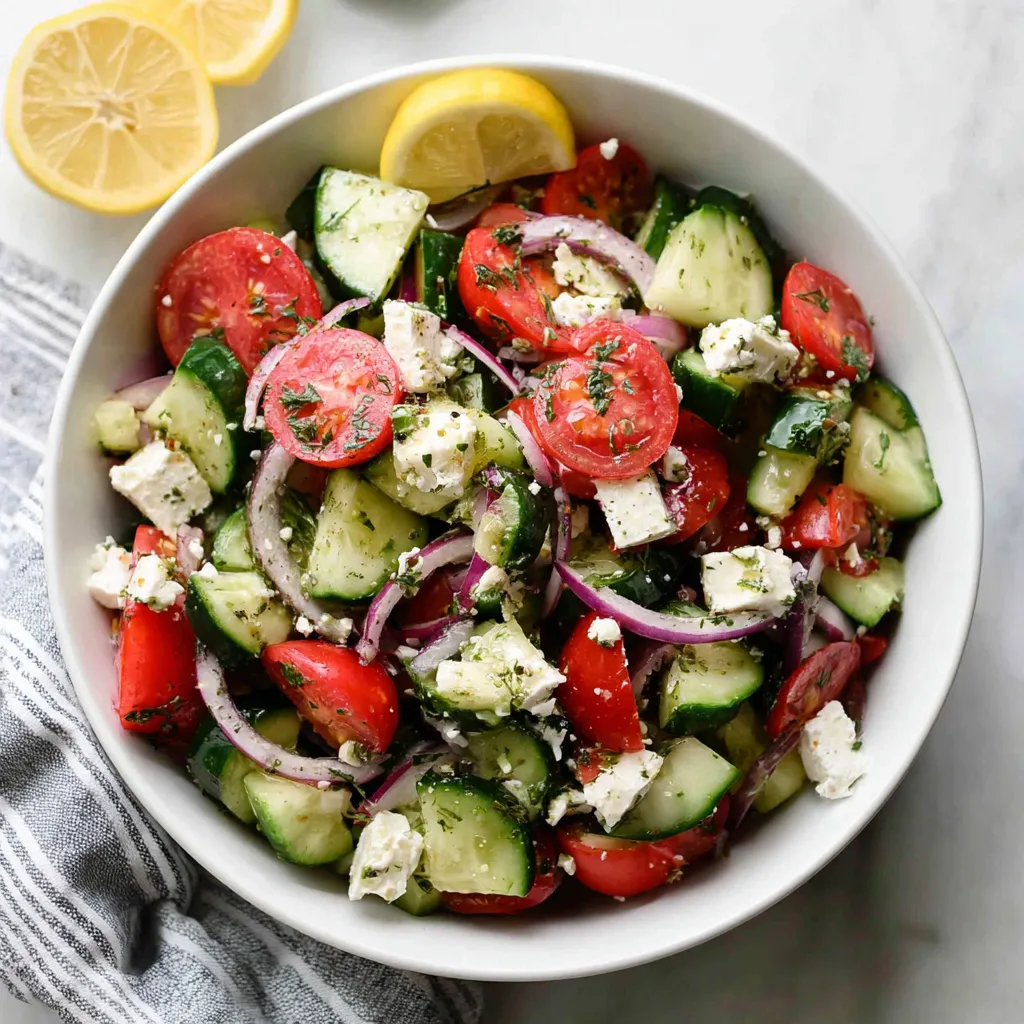 Bookmark
Bookmark
This fresh Greek cucumber salad transforms simple ingredients into a vibrant Mediterranean dish that's perfect for hot summer days. The crisp vegetables, tangy dressing, and creamy feta create a balanced flavor profile that's both refreshing and satisfying, making it ideal as a side dish or light lunch.
I first made this salad for a backyard gathering when temperatures hit triple digits, and it was the first empty bowl on the table. Since then, it's become my go-to contribution for potlucks and family dinners during warmer months.
Ingredients
- Cucumbers provide the refreshing crunch that forms this salad's foundation. Look for firm ones without soft spots for best texture.
- Roma tomatoes offer sweet juiciness without making the salad too watery. Choose ripe but firm tomatoes for optimal flavor.
- Red onions add a pleasant sharpness that balances the other flavors. Slice them thinly to avoid overwhelming the dish.
- Feta cheese brings creamy saltiness that ties everything together. Traditional Greek feta made from sheep's milk provides the most authentic flavor.
- Black olives contribute briny richness. Kalamata olives make an excellent authentic alternative if available.
- Olive oil forms the base of the dressing. Use extra virgin for the best flavor profile.
- Fresh lemon juice brightens the entire dish. Always use freshly squeezed for a cleaner, more vibrant taste.
- Dried oregano adds characteristic Greek flavor. Mediterranean oregano has a more intense flavor than Mexican varieties.
- Maple syrup or honey balances acidity with gentle sweetness. Pure maple syrup offers a more complex flavor profile.
- Garlic provides aromatic depth to the dressing. Fresh minced garlic is significantly more flavorful than pre-packaged alternatives.
Step-by-Step Instructions
- Prepare the Dressing
- Combine olive oil, freshly squeezed lemon juice, dried oregano, maple syrup, minced garlic, salt, and pepper in a small bowl. Whisk thoroughly until the dressing emulsifies and becomes slightly thickened. Allow flavors to marry while you prepare the vegetables.
- Prepare the Vegetables
- Slice cucumbers into quarter-inch thick half-moons for the perfect bite size. Cut roma tomatoes into bite-sized chunks, ensuring they're similar in size to the cucumber for consistent texture. Slice red onions thinly to provide flavor without overwhelming the salad. Halve the olives to distribute their briny flavor throughout the dish.
- Assemble the Salad
- Place all prepared vegetables in a large mixing bowl, ensuring you have ample space for tossing. Pour the prepared dressing evenly over the vegetables. Gently toss everything together using two large spoons or your hands until all components are evenly coated with dressing.
- Finish and Serve
- Sprinkle crumbled feta cheese over the dressed salad just before serving. This prevents the cheese from absorbing too much dressing and maintains its distinct texture. Serve immediately or refrigerate briefly to enhance flavors.
 Bookmark
Bookmark
My secret weapon in this recipe is the touch of maple syrup in the dressing. Many traditional recipes skip this ingredient, but I discovered it beautifully balances the acidity of the lemon juice while enhancing the natural sweetness of the vegetables. My Greek grandmother might consider it sacrilege, but even she admitted it was a delicious addition when I served it at our family reunion last summer.
Make-Ahead Tips
This salad actually improves with a bit of time, making it perfect for meal prep. For best results, prepare all components but keep the dressing separate until about 30 minutes before serving. This allows vegetables to maintain their crispness while still absorbing the flavors. If preparing more than four hours ahead, consider holding the tomatoes and feta until just before serving for optimal texture and presentation.
Serving Suggestions
While delicious on its own, this Greek cucumber salad pairs beautifully with grilled proteins like chicken souvlaki, lamb chops, or even simple grilled fish. For a complete Mediterranean meal, serve alongside warm pita bread and hummus. During hotter months, I often add a can of drained chickpeas to transform this side dish into a protein-rich main course that requires no cooking at all.
Customization Options
This recipe welcomes personalization based on preferences and availability. Bell peppers add sweet crunch and vibrant color. Fresh herbs like mint, parsley, or dill provide aromatic complexity. For added protein, incorporate chickpeas or white beans. Avocado brings creamy richness for a California-inspired variation. Consider swapping traditional feta for dairy-free alternatives if needed, though the flavor profile will change slightly.
Cultural Context
This simple salad has deep roots in Greek culinary tradition, where fresh, seasonal ingredients are celebrated with minimal preparation. Traditional Greek horiatiki salad typically includes cucumbers, tomatoes, onions, feta, and olives dressed simply with olive oil and oregano. This adaptation maintains authentic flavors while incorporating a slightly sweetened dressing that appeals to contemporary palates. In Greek culture, such salads are often served family-style as part of a larger meal featuring multiple small dishes.
Recipe FAQs
- → What can I substitute for feta cheese in this Greek cucumber salad?
If you're avoiding feta, you can substitute with crumbled goat cheese for a similar tangy flavor, or use dairy-free alternatives like tofu feta. For a completely cheese-free version, add extra olives or some capers to maintain the salty element that feta provides.
- → How far in advance can I prepare this salad?
For optimal freshness, prepare the vinaigrette up to 3 days ahead and store separately. Cut vegetables can be prepared up to 24 hours in advance and stored in separate containers. Combine all components just before serving to prevent the vegetables from becoming soggy.
- → Can I add other vegetables to this Greek salad?
Absolutely! Bell peppers, avocado, artichoke hearts, and chickpeas make excellent additions. For a heartier version, add cooked quinoa or orzo pasta. Just maintain the ratio of vinaigrette to ingredients to ensure proper flavor distribution.
- → What's the best way to slice cucumbers for this salad?
For the best texture, slice cucumbers into thin quarter-rounds (about ¼ inch thick). If using larger cucumbers with tough seeds, consider scooping out the seeds before slicing. English or Persian cucumbers work particularly well as they have fewer seeds and thinner skin.
- → How can I make this Greek cucumber salad more filling?
To transform this into a main dish, add protein like grilled chicken, shrimp, or chickpeas. You can also incorporate cooked quinoa, farro, or orzo pasta. For a low-carb option, add hard-boiled eggs or extra feta cheese to increase protein content while maintaining the Mediterranean flavor profile.
- → What's the best olive oil to use for the vinaigrette?
Extra virgin olive oil provides the best flavor for this Greek vinaigrette. Look for Greek or other Mediterranean olive oils which tend to have the robust, fruity qualities that complement the lemon and herbs in this dressing.
